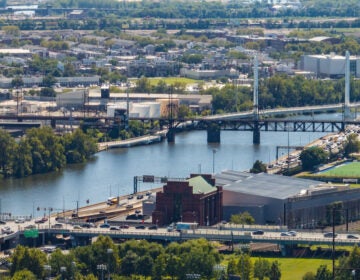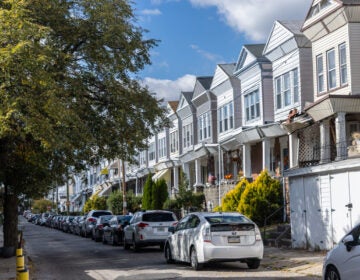In Chestnut Hill, it’s historical preservation by committee
In Chestnut Hill, history stands for itself – literally.
Many of the longstanding buildings in the affluent Northwest Philadelphia community were built with a unique “Chestnut Hill stone,” or Wissahickon schist, from a local quarry.
But what a simple stroll down the avenue can’t provide is a visual of the architecture that was lost before the Chestnut Hill Historical Society’s inception in 1967.
The existence of the society has been vital to raising awareness of the community’s historical richness; the same richness that allowed the neighborhood to be listed on the National Register of Historic Places in 1985.
Lost history
Take for example the Kerper House, which was believed to have been built in 1780 but was torn down in 1949 to make way for an automobile showroom at Germantown Avenue and Hartwell Lane.
Or a Tudor-style home at 8810 Norwood Ave. that was knocked down by the Chestnut Hill Hospital even after the society formed, and despite pressure by its members.
The Chestnut Hill Hotel, located at 8229 Germantown Ave., is another case in point.
In the 1950s, during a shopping district overhaul led by the neighborhood’s unofficial “mayor,” Lloyd Wells, the hotel lost some of its key Victorian elements.
“[Wells] wanted to play into this colonial revival,” said David Contosta, author of Suburb in the City, a book on the neighborhood’s history, in a recent interview.
Patricia Cove, vice president for preservation at the CHH, said “when the hotel was built in 1894, it was a Victorian building and on each of the corners of the buildings were large turrets, which are very Victorian architectural features.”
“Because the avenue was really not up to par, as far as the retail end, [Wells] decided to create a marketing concept and colonialize the entire avenue,” Cove continued. “[Wells’] aim was to take some of the buildings that were really not as specific architecturally, and turn them into more of a colonial facade.”
Reviving the neighborhood’s history
Ron Pete, the current owner of the Chestnut Hill Hotel, is working to restore some of the neighborhood’s history with his building.
Since Pete and his wife, Abby, purchased the hotel in 2007, they have implemented a years-long project to refurbish the interior and exterior of the hotel.
Cove, who also operates Patricia M. Cove, Architectural Interiors & Design, oversaw the exterior renovations.
“I thought, well, what a good way to bring back some remembrance of those turrets by actually curving the outside porches and balconies up on the second floor,” Cove said. “When you go outside now, you do see almost a replication of those turrets, in the way that the balcony and the porch had been designed.”
But that isn’t the only way the hotel is now offering a taste of history.
Renovations to the 36-bedroom hotel – which consists of three individual properties – additionally included giving each building a specific theme.
The “carriage house,” which Pete said is believed to have been used as a carriage garage and old car barn, bears a rustic feeling. Some of the original wood panels in the building remain, and one of the room’s beds is topped with the frame and wheels of a carriage lift.
The “post office building” – which houses a post office – was assigned a 1950s theme down to the small postcards in the room.
The Petes have also added old photos and maps of the neighborhood to its walls.
“The neighborhood can relate to it,” said Ron Pete. “[Abby] spent four months just picking out the pictures.”4
Anne McNally, co-owner of McNally’s Tavern, has also tried to keep Chestnut Hill’s historical roots alive. She said keeping her business basic, as it was founded, has helped it thrive.
While the pub has changed a lot in terms of its purpose and who it serves, the structure has largely gone untouched since it opened in the 1920s, save for some small renovations.
Snapshots of neighborhood history also line the walls of her restaurant, which sits just north of the hotel at 8634 Germantown Ave.
Building with an eye on history
Even prominent developers, like Richard Snowden, founder of Bowman Properties, said he works to ensure the neighborhood’s history doesn’t fall by the wayside. Snowden said his company tries to tread lightly on historical properties.
“To me, I have a successful project if, visually, when we’re finished, no one is really quite sure whether we were there or not,” he said.
However, Snowden admits sometimes work needs to be done in order for buildings to sustain themselves – be it replacing windows or installing new systems.
Bowman’s plans to build a five-story Fresh Marke-ancohered project at 8200 Germantown Ave. are meant to fill a void for grocery shoppers. He said his company is committed to maintaining Chestnut Hill’s identity as a residential community.
Preserving what remains
With yesteryear’s lessons in mind, those withCHHS know that preserving landmarks is all about awareness.
“Before we came what we are today, people could just remove a house,” Cove said. “Now, because we exist, and we have put our message out there that it is very important to maintain these buildings, people are much more aware.”
“If you don’t maintain it, you lose that honor,” she added.
WHYY is your source for fact-based, in-depth journalism and information. As a nonprofit organization, we rely on financial support from readers like you. Please give today.




